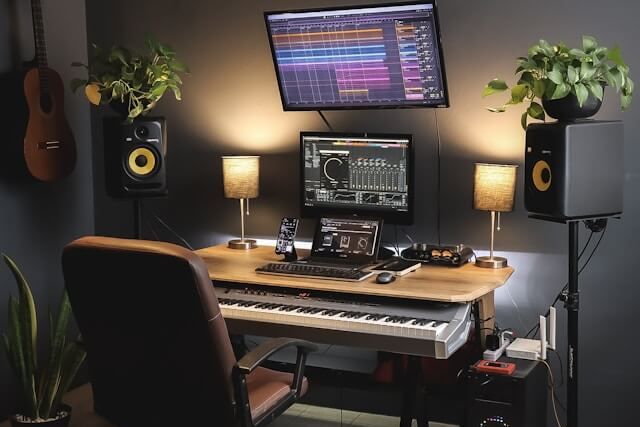Virtual reality is no longer confined to gaming and entertainment—it’s quickly becoming a transformative tool in music production. With VR technology now more accessible and software options expanding, musicians and producers are finding new creative spaces in virtual environments. Building a VR music studio at home might seem like a costly endeavor at first glance, but with careful planning, the right tools, and a bit of resourcefulness, it’s entirely possible to create an immersive and functional VR setup without breaking the bank.
Choosing the Right VR Headset for Music Creation
The cornerstone of any VR music studio is the headset, and fortunately, there are budget-friendly options available that don’t sacrifice too much on quality. Devices like the Meta Quest 2 and Quest 3 have gained popularity due to their affordability, portability, and versatility. These headsets can run standalone VR music apps or connect to a PC for more powerful software experiences.
When choosing a headset, it’s important to consider comfort for extended use, audio capabilities, and compatibility with music software. While built-in speakers are adequate for casual use, many users prefer to pair their headset with quality over-ear headphones to get more accurate sound for mixing and composing.
Affordable VR Music Software Options
Once the hardware is in place, the next step is selecting software that fits your musical goals and budget. A number of VR applications are designed specifically for music production and live performance, offering virtual instruments, mixing tools, and immersive sound environments.
Apps like PatchWorld, Virtuoso, and SoundStage VR provide hands-on experiences with virtual synthesizers, drum machines, loop stations, and more. These platforms are often far more affordable than traditional digital audio workstations (DAWs) and offer an intuitive, visual approach to music-making. Some even allow users to export their creations for use in professional audio software, making them suitable for both experimentation and serious production.
Many of these apps come with free trials or lite versions, so users can test them before investing. Over time, additional sound packs and features can be added based on individual needs and budgets.
Setting Up a Functional Physical Space
Even though a VR music studio lives largely in the virtual world, having a designated physical space is crucial for comfort and efficiency. The good news is that you don’t need a large or specially constructed room. A small, clear area with enough room to move your arms freely is typically sufficient. Removing obstacles and breakable items ensures safe movement, especially when you’re wearing a headset and can’t see your surroundings.
A comfortable chair, decent lighting, and proper cable management can go a long way in making the space user-friendly. If your VR setup requires a tethered connection to a PC, ensure that the cable is secured and long enough to allow freedom of movement without creating a tripping hazard.
Using Budget Gear to Enhance Your Setup
While the core of your studio is the VR headset and software, a few low-cost accessories can significantly enhance your experience. MIDI controllers, portable microphones, and external audio interfaces can all be integrated with many VR setups, offering tactile control and higher-quality sound input. These tools are often available secondhand or through budget brands known for solid performance at lower prices.
Another useful addition is a decent pair of closed-back headphones. They help isolate sound, improve mixing accuracy, and enhance the overall immersion of your VR environment. In some cases, studio monitors or small desktop speakers might be used in tandem when not working inside the headset.
Learning and Evolving on a Budget
Creating a VR music studio doesn’t require formal training or expensive equipment—it thrives on curiosity and experimentation. Online communities, video tutorials, and forums dedicated to VR music production offer a wealth of free knowledge for beginners and seasoned musicians alike. Following these resources allows you to continuously improve your skills and make the most out of your setup without extra cost.
Over time, as your needs and abilities grow, you can upgrade individual elements of your studio incrementally. The beauty of a VR music studio is its scalability—start small, learn the ropes, and expand as your creativity and confidence grow.
A New Frontier for Creators
Building a budget-friendly home VR music studio is about blending imagination with smart planning. With the right tools and a DIY mindset, musicians at any level can access immersive soundscapes and interactive instruments once only available in professional environments. Virtual reality not only lowers the cost barrier but also opens new artistic possibilities, allowing creators to explore music in dynamic and innovative ways—all from the comfort of home.
Refer to these sources for related topics:
https://c2bir.org/
https://seabreezetinyhomes.com/
https://lidolimarangi.it/
https://situspokerbagus.com/
https://mvcfashionn.com/
https://informagiovanicirie.net/
https://ebrain-news.com/
https://cbdisolateherms.com/
https://cbdcrowdfund.com/
https://pokernews.info/
https://rospedia.com/
https://avataresyfirmas.com/
https://onvd.org/
https://thinkingcreatively.org/
https://tvoicelessons.com/
https://halfashoestring.com/
https://ipsecurityforum.it/
https://visitandrun.com/
https://iraq-live.com/
https://fashioncn.org/
https://healthcareforgunner.com/
https://lookoff.co/
https://free-download-casino.com/
https://freshamericannews.com/
https://steelvalleyarts.org/
https://homeinsuredbyus.com/
https://marijuanadispensarynearmeshop.com/
https://simsoncasino.com/
https://fvtlaw.net/
https://atlanticcwm.com/
